| |
|
TITYRAS, BECARDS & ALLIES
Tityridae |
- 33 species in the Neotropics
- DR personal total: 20 species (60%), 9
photo'd
|
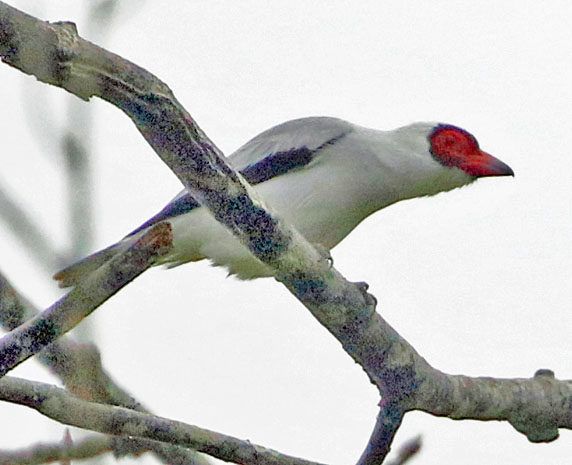 The Tityridae is a small but diverse family of Neotropical birds. Species occur from the southern border of the United State all the way to Argentina. One recent text summarized that they were "a sampler and grab-bag of Neotropical suboscine diversity [within the] this huge [tyrannid] radiation. Although all are upright, large-headed, with white, gray, black, and brown predominating their plumages, this group contains species as varied as the butcherbird-like Tityras, the manakin-like Schiffornis, the small compact Purpletufts, and the cotinga-like Mourners" (Winkler et al. 2015). A common and widespread example is Masked Tityra (left): a large tityra of tropical and subtropical forests, often found in the canopy of fruiting trees, or atop branches overlooking the habitat. The Tityridae is a small but diverse family of Neotropical birds. Species occur from the southern border of the United State all the way to Argentina. One recent text summarized that they were "a sampler and grab-bag of Neotropical suboscine diversity [within the] this huge [tyrannid] radiation. Although all are upright, large-headed, with white, gray, black, and brown predominating their plumages, this group contains species as varied as the butcherbird-like Tityras, the manakin-like Schiffornis, the small compact Purpletufts, and the cotinga-like Mourners" (Winkler et al. 2015). A common and widespread example is Masked Tityra (left): a large tityra of tropical and subtropical forests, often found in the canopy of fruiting trees, or atop branches overlooking the habitat.
For many years, this family did not exist. When I began traveling the USA — and then the word — for life birds, the current members of this family were considered to be Cotingas, Manakins, or New World Flycatchers [Tyrannidae]. |
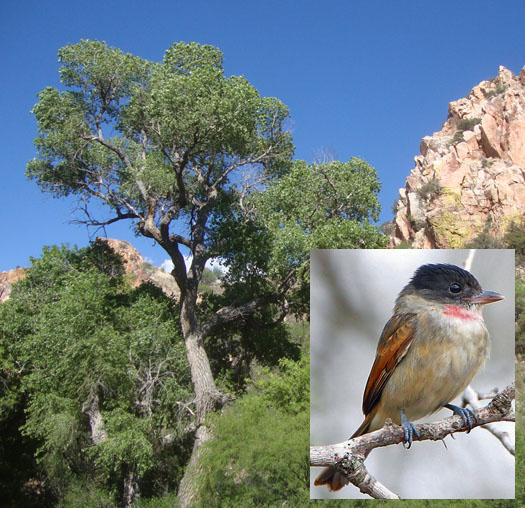
There was just one of them in the United States — Rose-throated Becard, which the field guide (Robbins et al. 1966) said was "rare and local along U.S.–Mexico border in Arizona, New Mexico, and Texas." Of course I wanted very much see that bird, and back then there was just one public-accessible location: the Patagonia rest stop along Sonoita Creek in southeast Arizona (right, in a spring photo from 2015 with an inset of a male Rose-throated Becard). On 10 June 1972, my friends Wally and Ken and I camped at the rest stop, saw the male becard, our first Varied Bunting, as well as a then-stakeout Five-striped Sparrow.
Our Five-striped Sparrow — considered even rarer than the becard back in those days —was the result of the "Patagonia Rest Stop effect." The phenomena occurs when an influx of birders chasing a rare bird at a site results in the discovery of more rare birds there, with the end result being that the locality becomes known for rare birds, even though in itself it may be little or no better than other similar sites. Thus the Rose-throated Becard not only was my first life bird among what is now the Tityridae, but its presence at this locale spawned a now-famous phenomena among the hard-core birding subculture. |
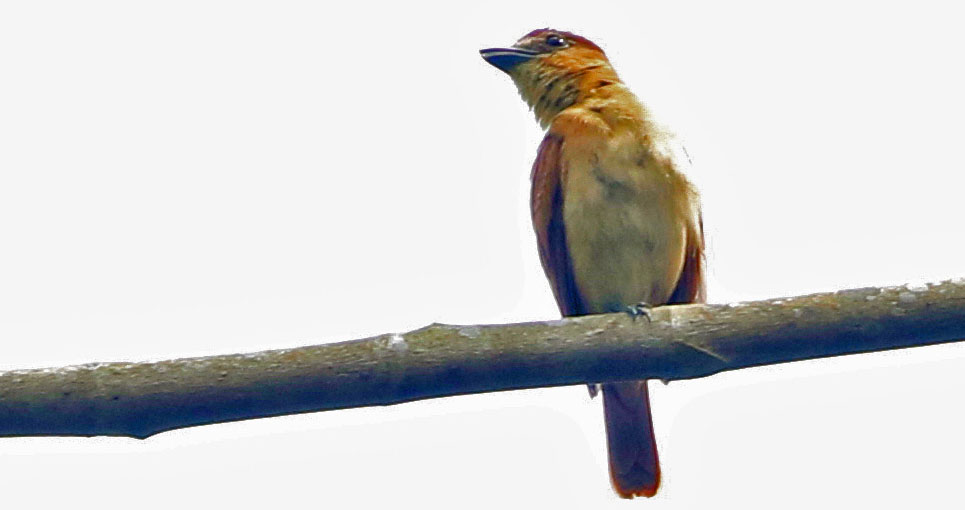 |
We've learned a lot about the Tityridae since the 1970s. While there are just three tityras in the family's namesake genus Tityra, there are now 16 species of becards in genus Pachyramphus. Accordingly, essentially half of the Tityridae are becard. Some of these becards have similar plumages that are quite similar in both male and female, such as the widespread Neotropical lowland species Cinnamon Becard (above), that ranges from Mexico to western Ecuador.
Another set are the dimorphic group of becards to which Rose-throated Becard belongs. There are four species of becards occurring from the U.S. border to Argentina in which the males are gray (some with and some without pink throats) and the females are rufous or cinnamon. From north to south these are Rose-throated Becard (male with rose throat), One-colored Becard Pachyramphus homochrous (all-gray male), Pink-throated Becard P. minor (male has pink throat), and Crested Becard P. vallidus (male gray, paler below); these species have allopatric distributions.
All are resident species, except that the northwestern populations of Rose-throated Becard (including the Arizona birds) move south into Mexico in winter.
Rose-throated Becards are notable for their bulky, messy, domed nests that are globular with an entrance near the bottom. The nests are suspended from the drooping ends of branchlets, often high above the ground. Females alone incubate, but both sexes build nests and feed young. To the extent that other becards have been studied, such dramatic nests are typical of the group. |
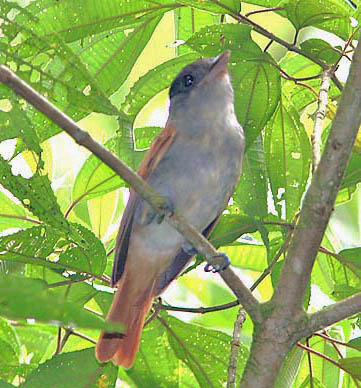 |
Another curiosity about Rose-throated Becard is that among its 8 currently recognized subspecies (Snow 1979), not all races have the rose-colored throat. Males on the Pacific slope of Costa Rica (race latirostris) are gray-throated; females have rufous wings and tail (left).
Then there is Jamaican Becard, the only becard in the Caribbean. Males are gray but the female (right) is patterned with gray, whitish, and cinnamon. A photo of is large, untidy, globular nest in the forests of foothill Jamaica is shown (below): |
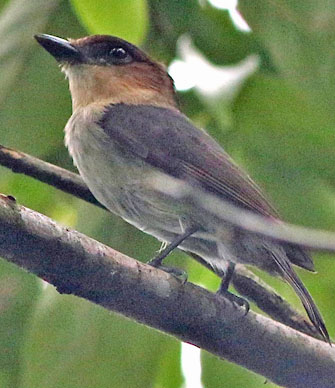 |
|
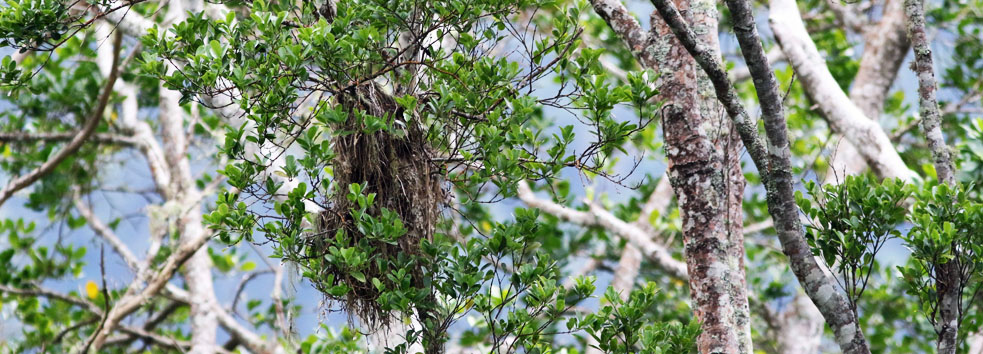 |
Uncertainty has long existed about the relationship of the suboscine
passerines in the Neotropics. There were two major groups — the
Tyrannida and the Furnariida (e.g., Sibley & Ahlquist 1990) — but
the relationships of the families within these two groups were
problematic. The most difficult was trying to find the boundaries
between Tyrant Flycatchers, Manakins, and Cotingas. Writing in his
introduction to a book on Cotingas, Snow (2004) wrote: "Following a
number of nineteenth-century anatomical studies, these three families
were distinguished from one another on the basis of the shape of the
bill and the scutellation of the tarsus, as well as whether or not the
toes were untied and, if they were, to what extent. It soon became
clear, however, that a classification based on these characters
contained awkward exceptions."
Recent molecular
studies have sorted out a good number of this "awkward exceptions." Based
on a congruence of multiple studies of molecular and morphological
characters, Ericson et al. (2006) formally proposed that the new family
be called the Tityridae. Included are species long assigned to Tyrant
Flycatchers (e.g., the tityras), to Cotingas (e.g., purpletufts and becards), and to
Manakins (e.g., the genus Schiffornis). I find the genus Schiffornis to be particularly interesting, as these are very overlooked but widespread species in Neotropical lowland and foothill forests. Once the molecular research got underway early this century, this "awkward" set of species was often called the "Schiffornis assemblage."
 Traditionally they had been termed Thrush-like Manakin Schiffornis turdinus, but by the publication of the 2d edition of Birds of Panama (Ridgely & Gwynne 1989), those authors used the English name Thrush-like Mourner. Although still placed among the Pipridae, that book noted that appear "not be allied to the true manakins, and certainly do not look or act like them." Instead, these quite birds perched "rather low, sometimes clinging up upright stems, peering about with a wide-eyed look, and rarely with mixed flocks." Although they gave "distinctive loud musical whistled songs," they were "not often seen except when caught in mis-nets." Traditionally they had been termed Thrush-like Manakin Schiffornis turdinus, but by the publication of the 2d edition of Birds of Panama (Ridgely & Gwynne 1989), those authors used the English name Thrush-like Mourner. Although still placed among the Pipridae, that book noted that appear "not be allied to the true manakins, and certainly do not look or act like them." Instead, these quite birds perched "rather low, sometimes clinging up upright stems, peering about with a wide-eyed look, and rarely with mixed flocks." Although they gave "distinctive loud musical whistled songs," they were "not often seen except when caught in mis-nets."
Now, the SACC calls birds in genus Schiffornis to be called Schiffornis in English — and now there are seven species replacing each other geographically from southeastern Mexico to Bolivia! (see Nyári 2007, Peterson & Nyári 2008). This is Russet-winged Schiffornis (right, in a shot by Terence Degan along Pipeline Road, Panama).
There still remain some "difficult" species that have not yet been
sorted out, but the main outlines of family Tityridae is now reasonably clear.
Over a decade ago, Sick (1993) wrote: "Their syringes and other
characters, as well as their ecology, indicate closer relationship to
the tyrannids than to the cotingids. For me, knowing these birds in
life, it was a relief to remove them from the cotingids, especially
considering that their nest types do not occur among cotingids." Now Included in the Tityridae are:
* An assemblage of 3 species of tityras (Tityra), 16 becards (Pachyramphus), and two mourners (genus Laniocera), plus
* The Schiffornis mourners (once 3 species, now been split into 7 species of Schiffornis), the 3 species of purpletufts (Iodopleura), and two species in monotypic genera: White-naped Xenopsaris Xenopsaris albinucha and "Shrike-like Cotinga," now usually called Elegant Mourner (Laniisoma elegans). These form
a monophyletic group (e.g. Lanyon 1985, Prum & Lanyon 1989, Prum et
al. 2000, Chesser 2004).
There have been debates over odd genera that, in the end, turn out not to be tityrids:
- The 3 species of piprites (Piprites) were once included in the Tityridae, but Piprites may be either a tyrant flycatcher (Ericson et al. 2006) or could even be assigned to a its own family (Ohlson et al. 2013).
- Kinglet Calyptura (Calyptura cristata) was once thought extinct but recently rediscovered and then it disappeared again!. It now appears to be a tyrannid.
- Swallow-tailed Cotinga (Phibalura flavirostris) was once considered uncertain, but most authorities continue to assign
it to its traditional family, the Cotingidae.
- The enigmatic Sharpbill (Oxyruncus cristatus) was once proposed to be in the Tityridae, and it is clearly not a cotinga (Ohlson
et al. 2007); for a time there was insufficient evidence
to firmly place it anywhere. Ericson et al. (2006) opined it was best assigned to its own monotypic family, and the SACC followed that approach, as do I for now.
|
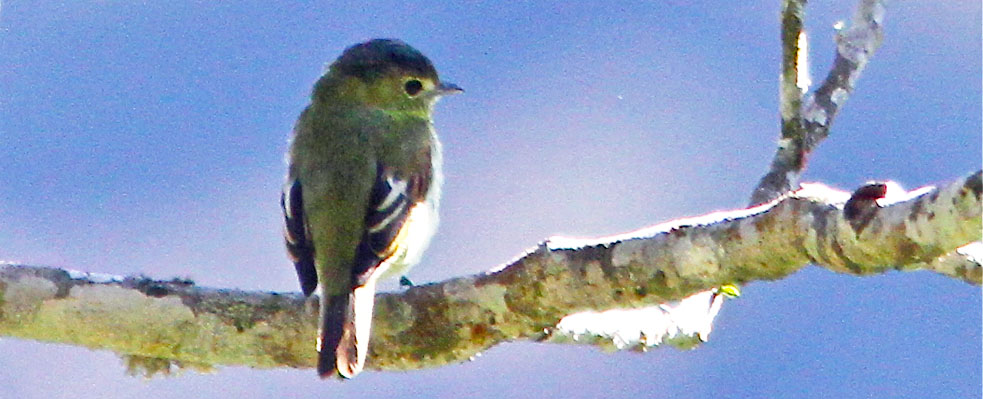 |
Molecular evidence shows that this is
a distinctive evolutionary grouping, but many have evolved to fit specific
niches. While
most members of the Tityridae are primarily fruit-eaters, others seem
to be primarily insectivores. Barred Becard (above) is a little becard of Andean forests. The male is mostly black with yellow cheeks, and whitish below, with narrow black barring The female has a distinctive combination of yellow underparts, a gray cap, a green back, and chestnut wings (this photo). This higher-elevation species is fairly active and pairs often join mixed-species canopy flocks.
In the lowlands, larger tityras can be conspicuous and
aggressive, and eat mostly fruit. Many becards sally after insects in the subcanopy. The quiet Schiffornises forage for insects in the understory. Rather little is known about a number of the mourners, or
the Xenopsaris of the Amazon basin.
A unique niche is filled by three species purpletufts. These live in small parties at the
forest edge and along rivers, and eat fruit, particularly mistletoe. This is White-browed Purpletuft (below, on mistletoe, in a lovely shot by Joseph Morlan). There is still a lot to be learned
about many of the interesting species in this "new" family.
|
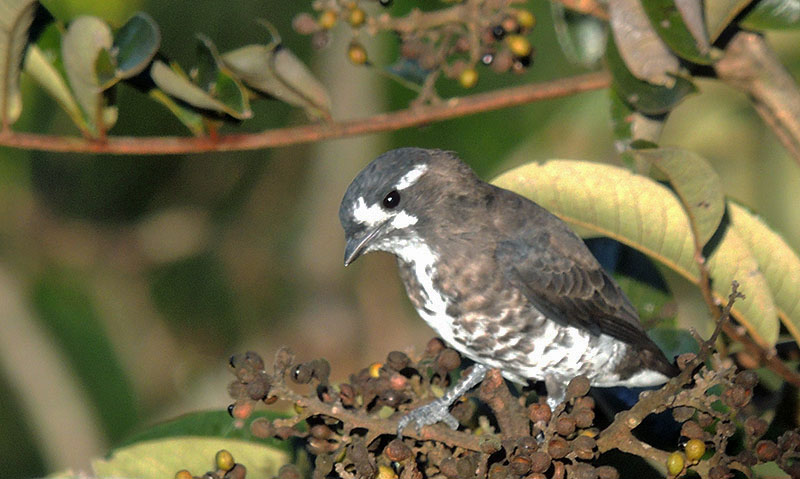 |
Photos: The Masked Tityra Tityra semifasciata
was at Nusagandi, Panama, on 9 Feb 2022. The male Rose-throated Becard
Pachyramphus aglaiae is a publicity photo by Sky Islet Tourism that I've inset in my photo of the Patagonia Rest Stop habitat on 2 May 2015. The Cinnamon Becard Pachyramphus cinnamomeus was at Reserva San Francisco, Panama, on 12 Feb 2022. My photo of a female Rose-throated Becard Pachyramphus aglaiae was at Rio Tigre, Osa Peninsula,
Costa Rica, on 26 Dec 2007. The female Jamaican Becard Pachyramphus niger, was along Ecclesdown Road, Jamaica, on 15 Feb 2017, and a nest was photographed in the forest at Hardware Gap, Jamaica, on 15 Feb 2022. Terence Degan photographed the Russet-winged Schiffornis Schiffornis stenorhyncha along Pipeline Road, Panama, on 16 Feb 2022. The Barred Becard Pachyramphus versicolor was at Reserva San Francisco, Panama, on 12 Feb 2022. Joseph Morlan photographed the White-browed Purpletuft Iodopleura isabellae at Rio Cristalino, Brazil, on 16 Feb 2022.
All photos © Don Roberson except photo of Schiffornis © Terence Degan and Purpletuft © Joseph Morlan, and used with
permission;
all rights reserved. The inset photo of Rose-throated Becard at the Patagonia rest stop photo is credited to Sky Island Tourism, and used pursuant to the "fair use" doctrine.
Bibliographic note: There is no "family book"
per se but members of the family have been covered in Handbook of the Birds of the World, but under various previously-assigned families. Vol. 9 of HBW
placed the 23 becards/tityras with Tyrant Flycatchers (Tyrannidae),
puts the Schiffornis assemblage in the Manakins (Pipridae), and
sequenced the Purpletufts, and Elegant Mourner, in the Cotingas (e.g., Snow 2004).
Literature cited:
Chesser, R.T. 2004. Molecular systematics of New World suboscine birds. Molec. Phylog. Evol. 32: 11–24.
Ericson,
P.G.P., D. Zuccon, J.I. Ohlson, U.S. Johansson, H. Alvarenga, and R.O.
Prum. 2006. Higher-level phylogeny and morphological evolution of
tyrant flycatchers, cotingas, manakins, and their allies (Aves:
Tyrannida). Molec. Phylog. Evol. 40: 471–483.
Johansson, U.S., T.J. Parsons, M. Irestedt, and P.G.P. Ericson. 2001.
Clades within "higher land birds," evaluated by nuclear DNA sequences.
J. Zool. Syst. Evol. Research 39: 37–51.
Lanyon, S.M. 1985. Molecular perspective on higher-level relationships in the Tyrannidae (Aves). Syst. Zool. 34: 404–418.
Lanyon, W.E. 1967. Revision and probable evolution of the Myiarchus flycatcher of the West Indes. Bull. Amer. Mus. Nat. Hist. 136: 329–370.
Ohlson,
J.I., R.O. Prum, and P.G.P. Ericson. 2007. A molecular phylogeny of the
cotingas (Aves: Cotingidae). Molec. Phylog. Evol. 42: 25–37.
Ohlson, J.L., M. Irestedt, G.P. Erickson, and J. Fjeldså. 2013. Phylogeny and classification of the New World suboscines (Aves, Passeriformes). Zootaxa 3613: 1–35.
Oliveros, C.H., D.J. Field, D.T. Ksepka, F.K Barker, A. Aleixo, M.J. Andersen, Per Alström, B.W. Benz, E.L. Braun, M.J. Braun, G.A. Bravo, R.T. Brumfield, R.T. Chesser, S. Claramunt, J. Cracraft, A.M. Cuervo, E.P. Derryberry, T.C. Glenn, M.G. Harvey, P.A. Hosner, L. Joseph, R.T. Kimball, A.L. Mack, C.M. Miskelly, A.T. Peterson, M.B. Robbins, F.H. Sheldon, L.F. Silveira, B.T. Smith, N.D. White, R.G. Moyle, and B.C. Faircloth. 2019. Earth history and the passerine superradiation. Proc. Nat. Acad. Sci. 116: 7916–7925.
Nyári, Á.S. 2007. Phylogeographic patterns, molecular and vocal differentiation, and species limits in Schiffornis turdina (Aves). Molec. Phylog. Evol. 44: 154–164.
Peterson, A.T. and Á.S. Nyári. 2008. Ecological niche conservatism and Pleistocene refugia in the Thrush-like Mourner, Schiffornis sp., in the Neotropics. Evolution. 62: 173–183.
Prum, R.O., and W.E. Lanyon. 1989. Monophyly and phylogeny of the Schiffornis group (Tyrannoidea). Condor 91: 444–461.
Prum, R.O., N.H. Rice, J.A. Mobley, and W.W. Dimmick. 2000. A
preliminary phylogenetic hypothesis for the cotingas (Cotingidae) based
on mitochondrial DNA. Auk 117: 236–241.
Ridgely, R.S., and G. Tudor. 1994. The Birds of South America. Vol. 2: The Suboscine Passerines. Univ of Texas, Austin.
Ridgely, R.S., and J.A. Gwynne, Jr. 1989. The Birds of Panama. 2d ed. Princeton Univ. Press, Princeton, N.J.
Robbins, C.S., B. Bruun, and H.S. Zim. 1966. A Guide to the Field Identification: Birds of North America. Golden Press, New York.
Snow, D.B. 2004. Family Cotingidae (Cotingas), pp. 32–108 in Del Hoyo,
J. Elliott, A., & Sargatal, J. eds. Handbook of the Birds of the
World. Vol. 9. Lynx Edicions, Barcelona.
Sibley, C.G., and J.E. Ahlquist. 1990. Phylogeny and Classification of Birds of the World. Yale Univ. Press, New Haven, CT.
Sick, H. 1993. Birds in Brazil: A Natural History. Translated from
Portuguese by W. Belton. Princeton Univ. Press, Princeton, N.J.
Tello, J.G., R.G. Moyle, D.J. Marchese, and J. Cracraft. 2009. Phylogeny and phylogenetic classification of tyrant-flycatchers, cotingas, manakins, and their allies (Aves: Tyrannides). Cladistics 25: 429–467.
Winkler, D.W., S.W. Billerman, and I.J. Lovette. 2015. Birds Families of the World: A Guide to the Spectacular Diversity of Birds. Lynx Edicions, Barcelona.
|
|
|





 The Tityridae is a small but diverse family of Neotropical birds. Species occur from the southern border of the United State all the way to Argentina. One recent text summarized that they were "a sampler and grab-bag of Neotropical suboscine diversity [within the] this huge [tyrannid] radiation. Although all are upright, large-headed, with white, gray, black, and brown predominating their plumages, this group contains species as varied as the butcherbird-like Tityras, the manakin-like Schiffornis, the small compact Purpletufts, and the cotinga-like Mourners" (Winkler et al. 2015). A common and widespread example is Masked Tityra (left): a large tityra of tropical and subtropical forests, often found in the canopy of fruiting trees, or atop branches overlooking the habitat.
The Tityridae is a small but diverse family of Neotropical birds. Species occur from the southern border of the United State all the way to Argentina. One recent text summarized that they were "a sampler and grab-bag of Neotropical suboscine diversity [within the] this huge [tyrannid] radiation. Although all are upright, large-headed, with white, gray, black, and brown predominating their plumages, this group contains species as varied as the butcherbird-like Tityras, the manakin-like Schiffornis, the small compact Purpletufts, and the cotinga-like Mourners" (Winkler et al. 2015). A common and widespread example is Masked Tityra (left): a large tityra of tropical and subtropical forests, often found in the canopy of fruiting trees, or atop branches overlooking the habitat.


 Traditionally they had been termed Thrush-like Manakin Schiffornis turdinus, but by the publication of the 2d edition of Birds of Panama (Ridgely & Gwynne 1989), those authors used the English name Thrush-like Mourner. Although still placed among the Pipridae, that book noted that appear "not be allied to the true manakins, and certainly do not look or act like them." Instead, these quite birds perched "rather low, sometimes clinging up upright stems, peering about with a wide-eyed look, and rarely with mixed flocks." Although they gave "distinctive loud musical whistled songs," they were "not often seen except when caught in mis-nets."
Traditionally they had been termed Thrush-like Manakin Schiffornis turdinus, but by the publication of the 2d edition of Birds of Panama (Ridgely & Gwynne 1989), those authors used the English name Thrush-like Mourner. Although still placed among the Pipridae, that book noted that appear "not be allied to the true manakins, and certainly do not look or act like them." Instead, these quite birds perched "rather low, sometimes clinging up upright stems, peering about with a wide-eyed look, and rarely with mixed flocks." Although they gave "distinctive loud musical whistled songs," they were "not often seen except when caught in mis-nets."